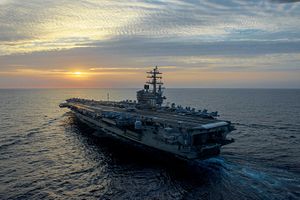For the first time in over two decades, two U.S. Navy carrier strike groups (CSG) are conducting joint naval exercises off the Korean Peninsula in the Sea of Japan in response to recent North Korean ballistic missile tests, the U.S. Navy revealed on May 31.
The nuclear-powered Nimitz-class aircraft carriers USS Ronald Reagan and USS Carl Vinson have begun dual-carrier operations, a U.S. Navy spokesperson told USNI News this Wednesday without providing additional details about the exercise.
“Operating two carrier strike groups in the Western Pacific provides unique training opportunities for our forces and provides combatant commanders with significant operational flexibility should these forces be called upon in response to regional situations,” the Navy spokesperson said.
“The presence of two carriers is part of a regularly scheduled rotation of assets in the region and is not in response to any political or world events. This unique capability is one of many ways the U.S. Navy promotes security, stability and prosperity throughout the Indo-Asia-Pacific.”
Only two days ago, a Pentagon official* said that both ships “are in the Western Pacific, but (…) not in close proximity to each other.”
The USS Carl Vinson’s deployment was extended by a month due to the volatile security situation on the Korean Peninsula. While deployed in the Asia-Pacific region, the aircraft carrier participated in a number of training exercises and conducted patrols in the South China Sea.
The USS Ronald Reagan, which departed Yokosuka naval base in Japan in the middle of May, has been engaged in flight deck and carrier qualifications to certify their ability to safely launch and recover aircraft.
“We will continue to be the centerpiece of visible maritime deterrence, providing our national command authority with flexible deterrent options, all domain access, and a visible forward presence,” the U.S. Navy spokesperson said.
It is likely that the two CSG will be joined by units of the Republic of Korea Navy for parts of the naval drills. Once the exercise is concluded, the USS Carl Vinson CSG will return to San Diego.
Replacing the USS Carl Vinson, will be the USS Nimitz, the lead ship of her class. The aircraft carrier and her support ships are scheduled to depart their homeports of Naval Station Kitsap-Bremerton and Naval Station Everett on June 1.
“It is unclear when and where the USS Nimitz will meet up with one of the other carriers,” I reported on May 30. “According to U.S. Navy sources, the USS Nimitz was originally scheduled to deploy to the Middle East, but recent tensions on the Korean Peninsula made the U.S. government decide to dispatch the ship to the Western Pacific.”
Once the Nimitz CSG deploys to the Western Pacific, three of the U.S. Navy’s 11 supercarriers will be present in the region.
*An earlier version of this article has mistakenly identified the U.S. naval official as a U.S. Pacific Command spokesperson.

































